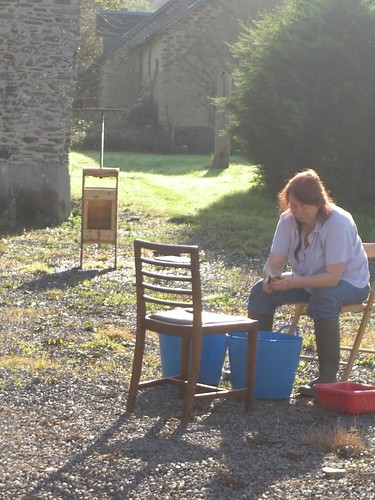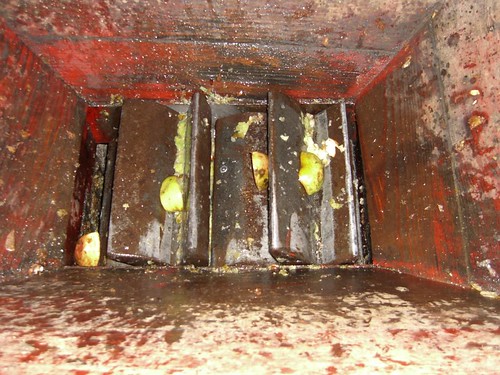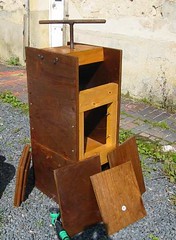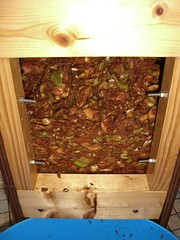
Having gathered about 120 kg of apples we sat down to prepare them. It was lucky that we had the most beautiful weather whilst we did this, it meant we could sit outdoors and soak up the sun as we worked.
After washing the fruit down with a hose we discarded any rotten apples and cut the rest into quarters and slices to enable them to go through the antique crushing machine in the pressing house. Our hands quickly became blistered even using the supersharp Opinel knives beloved of the french handyman. It took us about an hour to chop two plastic trugs of apples into pieces.

Although the crusher is clearly designed to take a hopper full of fruit and turn continuously either driven by a belt or some more direct sort of motive force we had to turn the teeth by rotating the wheel by hand. This is very hard work and if the apple pieces were too large or the teeth overfilled it was beyond our strength to turn it. The only way to make progress was for one of us to rather pathetically drop the apples bits one by one into the teeth while the other turned the wheel. The apples were put through the scratter twice in an attempt to crush them nice and small for maximum juice extraction. This was exhausting and taking turns it still took another hour to crush two trugs of prepared fruit.


Once we had our nicely crushed pulp it was time to extract the juice. With much regret we decided not to attempt to use the huge ancient press that came with the house - our tiny quantity of pulp would have been lost even if there hadn't been other issues of rot and missing parts to address. We'll have to resolve those problems over the next year whilst gathering bodies to help for a full harvest.
Luckily we have a small press that was crafted by Paul's Dad, originally for grapes from his back garden but sturdy enough and sufficiently capacious to take a trug's worth at a time. As each variety of apple was processed the juice was gathered into a clean container and a minimum amount of camden tablets added to discourage fermentation and kill noxious bacteria and moulds until we were ready to start the ferment. This stage of the process took about another hour per two trugs, with picking making slightly more than 20 hours back breaking work to process the whole lot. Far too exhausting to do all at once we took about 4 days to stage ourselves through the work.
We taste tested each batch as it was done. The juice was muddy brown and not particularly attractive but we needed to know if it was worth our effort to continue. Beatrice was lovely and sweet but Katherine too sharp for comfortable drinking. We thought this was a hopeful sign although we had yet to test the juice for acidity it seemed we might have sufficient variety in our juice to make a good cider.
The next section of this Cider Making blog will show how we tested the juice more formally and the way the ferment was started, watch this space.
1 comment:
Hello hope you are well.
You have just been tagged, please see
http://pcbloggs.blogspot.com/2006/11/tagging.html
Post a Comment